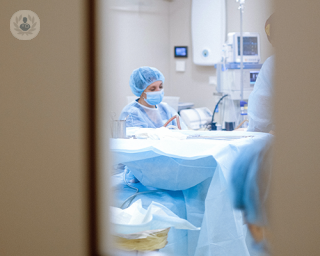Endovascular surgery
Mr Akin Oluwole - Vascular surgery
Created on: 10-20-2015
Updated on: 04-21-2023
Edited by: Jay Staniland
What is endovascular surgery?
Endovascular surgery is a minimally invasive surgery performed under local anaesthetic. A range of endovascular techniques are employed to unblock, repair, or reroute blood vessels to treat various cardiovascular conditions. These techniques are less invasive than open vascular surgery and can lead to fewer complications after the operation.

What is endovascular surgery used for?
This type of surgery is often done to treat an aortic aneurysm. Abdominal aortic aneurysm can arise as a consequence of unhealthy lifestyle choices, such as smoking, stress, lack of physical activity and eating an unhealthy diet.
When treating an aneurysm, the main goal is to avoid the rupturing of the aneurysmal sac; that is accomplished with the use of a specific stent. On the other hand, when treating a stroke, endovascular surgery aims at eliminating the obstructions from within the arteries.
This branch of surgery also treats conditions such as stroke, stenosis, peripheral arterial disease and other issues associated with the vascular system.
What does endovascular surgery involve?
Endovascular surgery involves making a small incision in the skin and passing a small tube called a catheter into a blood vessel at the target site.
Whenever endovascular surgery is done to treat an aneurysm of the visceral arteries, a small cut is made at the inguinal level to insert a catheter which will gain access to the femoral artery. The catheter then reaches the aneurysm and cuts off the blood supply to the aneurysmal sac by using a stent and embolisation agents.
In the case of a stroke, the catheter can be inserted from the femoral artery and passed through to the brain. Once it has reached the clot, the catheter releases a stent which will restore normal blood flow. When removing the stent, the clot will be removed as well.
How can I prepare for endovascular surgery?
You will need to have a few tests before an endovascular surgery procedure, to make sure you don’t have any severe coagulopathies, as these could be life-threatening during the procedure. The surgeon and anaesthetist will also ask about your medical history to foresee any potential complications.
Post-operative progress
You will usually be able to go home within two days after the procedure. You should be able to go back to work after one week, but complete recovery takes approximately one month.
It is important that you follow the doctor’s directions when it comes to which medications you can take and when you need to go for a follow-up appointment.
Other treatment options
Endovascular surgery may be recommended in conjunction with other types of treatment, depending on what cardiovascular condition you have. For example, in the case of a stroke, roughly one third of the cases can be treated with medication, although that only works if the clot is fairly small.











